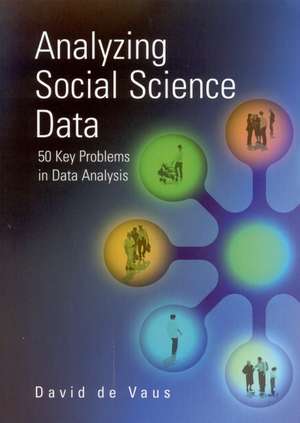Analyzing Social Science Data: 50 Key Problems in Data Analysis
Autor David de Vausen Limba Engleză Paperback – 13 iun 2002
`I'm full of admiration for this book. Once again, David de Vaus has come up with a superb book that is well written and organized and which will be a boon to a wide range of students. He has taken a vast array of problems that users of quantitative data analysis procedures are likely to encounter. The selection of issues and problems ... reflects the experience of a true practitioner with a grasp of his field and of the intricacies of the research process. The selection of issues clearly derives also from experience of teaching students how to do research and analyse data....A large number of practitioners will want the book. I was surprised at how much I learned from this. This will be a vital book for the bookshelves of practitioners of the craft of quantitative data analysis' - Alan Bryman, Professor of Social Research, Loughborough University
Preț: 737.75 lei
Preț vechi: 1010.61 lei
-27% Nou
Puncte Express: 1107
Preț estimativ în valută:
141.17€ • 148.07$ • 117.52£
141.17€ • 148.07$ • 117.52£
Carte tipărită la comandă
Livrare economică 01-15 aprilie
Preluare comenzi: 021 569.72.76
Specificații
ISBN-13: 9780761959380
ISBN-10: 0761959386
Pagini: 402
Dimensiuni: 170 x 242 x 24 mm
Greutate: 0.74 kg
Ediția:First Edition
Editura: SAGE Publications
Colecția Sage Publications Ltd
Locul publicării:London, United Kingdom
ISBN-10: 0761959386
Pagini: 402
Dimensiuni: 170 x 242 x 24 mm
Greutate: 0.74 kg
Ediția:First Edition
Editura: SAGE Publications
Colecția Sage Publications Ltd
Locul publicării:London, United Kingdom
Cuprins
PART ONE: HOW TO PREPARE DATA FOR ANALYSIS
How to Code Data
How to Code Questions with Multiple Answers
Can the Respondent's Answers be Relied on?
How to Check that the Right Thing is Being Measured
TWO: HOW TO PREPARE VARIABLES FOR ANALYSIS
How to Deal with Variables with Lots of Categories
How to Identify and Change the Level of Measurement of Variables
How to Deal with Questions that Fail to Identify Real Differences Between Cases
How to Rearrange the Categories of a Variable
What to do with Gaps in the Data
What to do with People who 'Don't Know', 'Have no Opinion' or 'Can't Decide'
How to Tell if the Distribution is Normal
How to Tell if the Relationship is Linear
How to Tell if Outlier Cases are a Problem
What to do if the Required Variable is not Available
How to Compare Apples with Oranges
Comparing Scores on Different Variables
PART THREE: HOW TO REDUCE THE AMOUNT OF DATA TO ANALYSE
How to Work Out Which Variables to Use
How to Combine Information from a Set of Variables into a Single Measure
How to Build a Good Likert Scale
How to Build a Scale Using Factor Analysis
PART FOUR: HOW AND WHEN TO GENERALISE
What Does it Mean to Generalize?
How to Judge the Extent and Effect of Sample Bias
How to Weight Samples to Adjust for Bias
What are Tests of Significance?
Should Tests of Significance be Used?
What Factors Affect Significance Levels?
Is the Sample Large Enough to Achieve Statistical Significance?
Should Confidence Intervals be Used?
PART FIVE: HOW TO ANALYSE A SINGLE VARIABLE
How to Use Tables Effectively to Display the Distribution of a Single Variable
How to Use Graphs for Single Variables
Which Summary Statistics to Use to Describe a Single Variable
Which Statistics to Use to Generalise about a Single Variable
PART SIX: HOW TO ANALYSE TWO VARIABLES
How and When to Use Crosstabulations
Which Graph to Use
How to Narrow down the Choice When Selecting Summary Statistics
How to Interpret a Correlation Coefficient
Which Correlation?
How much Impact Does a Variable Have?
How to Tell if Groups are Different
Which Test of Significance?
How are Confidence Intervals used in Bivariate Analysis?
PART SEVEN: HOW TO CARRY OUT MULTIVARIATE ANALYSIS
Understanding Bivariate Relationships
The Logic of Elaboration Analysis
Using Conditional Tables as a Method of Elaboration Analysis
Using Conditional Correlations for Elaboration Analysis
Using Partial Tables as a Method of Elaboration Analysis
Using Partial Correlations for Elaboration Analysis
What Type of Data are Needed for Multiple Regression?
How to do a Multiple Regression
How to Use Non-interval Variables in Multiple Regression
What Does the Multiple Regression Output Mean?
What Other Multivariate Methods are Availabe?
How to Code Data
How to Code Questions with Multiple Answers
Can the Respondent's Answers be Relied on?
How to Check that the Right Thing is Being Measured
TWO: HOW TO PREPARE VARIABLES FOR ANALYSIS
How to Deal with Variables with Lots of Categories
How to Identify and Change the Level of Measurement of Variables
How to Deal with Questions that Fail to Identify Real Differences Between Cases
How to Rearrange the Categories of a Variable
What to do with Gaps in the Data
What to do with People who 'Don't Know', 'Have no Opinion' or 'Can't Decide'
How to Tell if the Distribution is Normal
How to Tell if the Relationship is Linear
How to Tell if Outlier Cases are a Problem
What to do if the Required Variable is not Available
How to Compare Apples with Oranges
Comparing Scores on Different Variables
PART THREE: HOW TO REDUCE THE AMOUNT OF DATA TO ANALYSE
How to Work Out Which Variables to Use
How to Combine Information from a Set of Variables into a Single Measure
How to Build a Good Likert Scale
How to Build a Scale Using Factor Analysis
PART FOUR: HOW AND WHEN TO GENERALISE
What Does it Mean to Generalize?
How to Judge the Extent and Effect of Sample Bias
How to Weight Samples to Adjust for Bias
What are Tests of Significance?
Should Tests of Significance be Used?
What Factors Affect Significance Levels?
Is the Sample Large Enough to Achieve Statistical Significance?
Should Confidence Intervals be Used?
PART FIVE: HOW TO ANALYSE A SINGLE VARIABLE
How to Use Tables Effectively to Display the Distribution of a Single Variable
How to Use Graphs for Single Variables
Which Summary Statistics to Use to Describe a Single Variable
Which Statistics to Use to Generalise about a Single Variable
PART SIX: HOW TO ANALYSE TWO VARIABLES
How and When to Use Crosstabulations
Which Graph to Use
How to Narrow down the Choice When Selecting Summary Statistics
How to Interpret a Correlation Coefficient
Which Correlation?
How much Impact Does a Variable Have?
How to Tell if Groups are Different
Which Test of Significance?
How are Confidence Intervals used in Bivariate Analysis?
PART SEVEN: HOW TO CARRY OUT MULTIVARIATE ANALYSIS
Understanding Bivariate Relationships
The Logic of Elaboration Analysis
Using Conditional Tables as a Method of Elaboration Analysis
Using Conditional Correlations for Elaboration Analysis
Using Partial Tables as a Method of Elaboration Analysis
Using Partial Correlations for Elaboration Analysis
What Type of Data are Needed for Multiple Regression?
How to do a Multiple Regression
How to Use Non-interval Variables in Multiple Regression
What Does the Multiple Regression Output Mean?
What Other Multivariate Methods are Availabe?
Notă biografică
David De Vaus is Associate Professor of Sociology at La Trobe University, Melbourne. He is the author of Surveys in Social Research and Research Design in Social Research. He is an international authority in the field of social research.
Descriere
In this novel and refreshing textbook David de Vaus directs students to the core of data analysis. The book is a lean and authoritative guide to the problems facing beginner's in the field.
















